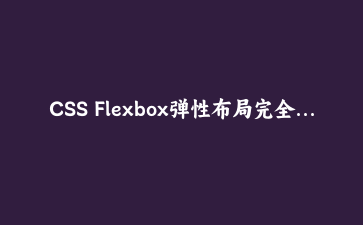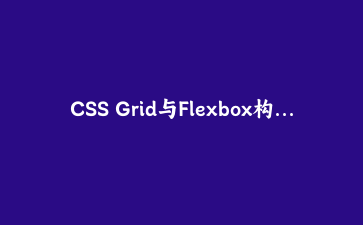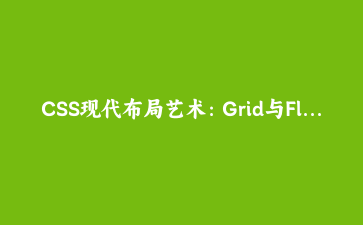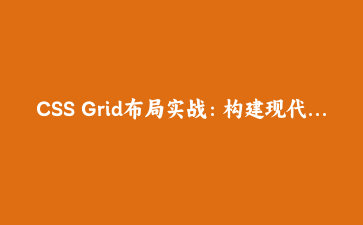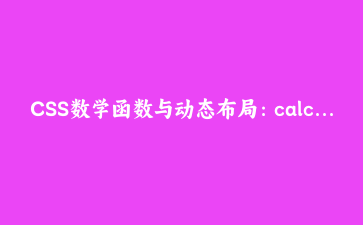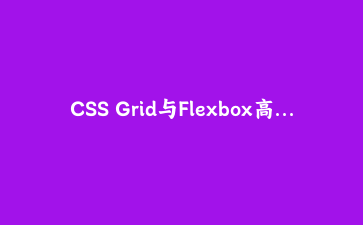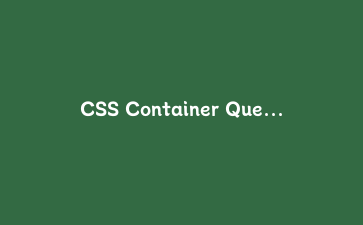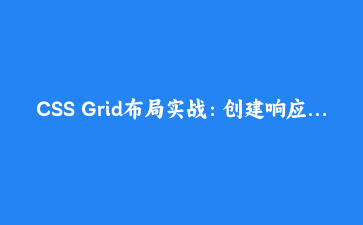一、Flexbox布局简介
Flexbox(弹性盒子布局)是CSS3中引入的一种一维布局模型,它能够更有效地对容器中的项目进行排列、对齐和空间分配。与传统的布局方式相比,Flexbox提供了更强大的灵活性,特别适合构建复杂的响应式界面。
Flexbox布局的优势:
- 简化复杂布局的实现
- 轻松实现垂直居中
- 自动计算项目尺寸和间距
- 优秀的浏览器兼容性
- 适应不同屏幕尺寸
基本术语:
在Flexbox布局中,我们主要处理两个核心概念:
- Flex容器(Flex Container):应用了
display: flex的元素 - Flex项目(Flex Items):Flex容器的直接子元素
二、核心概念解析
主轴与交叉轴
Flexbox布局基于两个轴:主轴(main axis)和交叉轴(cross axis)。
- 主轴:由
flex-direction属性定义的方向 - 交叉轴:垂直于主轴的方向
Flex容器示例代码:
.flex-container {
display: flex;
flex-direction: row; /* 定义主轴方向 */
justify-content: center; /* 主轴对齐方式 */
align-items: center; /* 交叉轴对齐方式 */
}Flex项目示例代码:
.flex-item {
flex: 1; /* 项目弹性系数 */
align-self: flex-start; /* 单个项目对齐方式 */
}三、容器属性详解
1. display属性
定义容器为Flex布局:
.container {
display: flex; /* 块级Flex容器 */
/* 或 */
display: inline-flex; /* 行内Flex容器 */
}2. flex-direction属性
定义主轴方向:
.container {
flex-direction: row; /* 默认值,水平排列 */
flex-direction: row-reverse; /* 水平反向排列 */
flex-direction: column; /* 垂直排列 */
flex-direction: column-reverse; /* 垂直反向排列 */
}3. justify-content属性
定义项目在主轴上的对齐方式:
.container {
justify-content: flex-start; /* 默认值,起始对齐 */
justify-content: flex-end; /* 末尾对齐 */
justify-content: center; /* 居中对齐 */
justify-content: space-between; /* 两端对齐 */
justify-content: space-around; /* 均匀分布 */
justify-content: space-evenly; /* 完全均匀分布 */
}4. align-items属性
定义项目在交叉轴上的对齐方式:
.container {
align-items: stretch; /* 默认值,拉伸填满 */
align-items: flex-start; /* 交叉轴起点对齐 */
align-items: flex-end; /* 交叉轴终点对齐 */
align-items: center; /* 交叉轴居中对齐 */
align-items: baseline; /* 基线对齐 */
}5. flex-wrap属性
定义项目是否换行:
.container {
flex-wrap: nowrap; /* 默认值,不换行 */
flex-wrap: wrap; /* 换行 */
flex-wrap: wrap-reverse; /* 反向换行 */
}四、项目属性详解
1. order属性
定义项目的排列顺序:
.item {
order: 0; /* 默认值 */
order: 1; /* 数值越大,排列越靠后 */
order: -1; /* 数值越小,排列越靠前 */
}2. flex-grow属性
定义项目的放大比例:
.item {
flex-grow: 0; /* 默认值,不放大 */
flex-grow: 1; /* 等分剩余空间 */
}3. flex-shrink属性
定义项目的缩小比例:
.item {
flex-shrink: 1; /* 默认值,空间不足时缩小 */
flex-shrink: 0; /* 空间不足时不缩小 */
}4. flex-basis属性
定义项目在分配多余空间之前的主轴尺寸:
.item {
flex-basis: auto; /* 默认值,项目本来大小 */
flex-basis: 100px; /* 固定尺寸 */
flex-basis: 20%; /* 百分比尺寸 */
}5. flex简写属性
flex-grow, flex-shrink 和 flex-basis的简写:
.item {
flex: none; /* 相当于 flex: 0 0 auto */
flex: auto; /* 相当于 flex: 1 1 auto */
flex: 1; /* 相当于 flex: 1 1 0% */
flex: 0 0 200px; /* 固定宽度,不放大不缩小 */
}6. align-self属性
允许单个项目有与其他项目不一样的对齐方式:
.item {
align-self: auto; /* 默认值,继承align-items */
align-self: flex-start;
align-self: flex-end;
align-self: center;
align-self: baseline;
align-self: stretch;
}五、实战应用案例
案例1:导航菜单布局
使用Flexbox创建响应式导航菜单:
.navbar {
display: flex;
justify-content: space-between;
align-items: center;
padding: 1rem;
background-color: #333;
}
.logo {
font-size: 1.5rem;
color: white;
}
.nav-links {
display: flex;
list-style: none;
gap: 1rem;
}
.nav-links a {
color: white;
text-decoration: none;
padding: 0.5rem 1rem;
}
@media (max-width: 768px) {
.navbar {
flex-direction: column;
}
.nav-links {
flex-direction: column;
width: 100%;
}
}案例2:卡片网格布局
创建自适应的卡片网格:
.card-container {
display: flex;
flex-wrap: wrap;
gap: 1rem;
justify-content: center;
}
.card {
flex: 1 1 300px;
max-width: 400px;
padding: 1rem;
border: 1px solid #ddd;
border-radius: 8px;
}
.card img {
width: 100%;
height: auto;
}案例3:圣杯布局实现
使用Flexbox实现经典的圣杯布局:
.holy-grail {
display: flex;
flex-direction: column;
min-height: 100vh;
}
.header, .footer {
padding: 1rem;
background-color: #f0f0f0;
}
.main-content {
display: flex;
flex: 1;
}
.sidebar {
flex: 0 0 200px;
background-color: #e0e0e0;
padding: 1rem;
}
.content {
flex: 1;
padding: 1rem;
}六、响应式布局技巧
1. 媒体查询与Flexbox结合
在不同屏幕尺寸下调整Flexbox属性:
.responsive-container {
display: flex;
flex-direction: row;
}
@media (max-width: 768px) {
.responsive-container {
flex-direction: column;
}
}2. 使用flex-wrap实现自适应
利用flex-wrap属性创建流动布局:
.adaptive-grid {
display: flex;
flex-wrap: wrap;
}
.adaptive-item {
flex: 1 1 200px; /* 最小宽度200px,自动换行 */
margin: 0.5rem;
}3. 间距控制技巧
使用gap属性或margin控制项目间距:
.spaced-items {
display: flex;
gap: 1rem; /* 现代浏览器支持 */
}
/* 兼容性方案 */
.spaced-items {
display: flex;
margin: -0.5rem; /* 负边距抵消 */
}
.spaced-items > * {
margin: 0.5rem; /* 项目间距 */
}七、最佳实践总结
1. 选择合适的布局方案
- 一维布局使用Flexbox
- 二维复杂布局考虑Grid
- 简单线性布局可使用传统方法
2. 性能优化建议
- 避免过度嵌套Flex容器
- 合理使用flex简写属性
- 考虑使用CSS Grid处理复杂网格
3. 浏览器兼容性处理
- 使用autoprefixer自动添加前缀
- 为旧版浏览器提供降级方案
- 测试不同浏览器的渲染效果
4. 可维护性建议
- 使用有意义的类名
- 保持CSS结构清晰
- 注释复杂布局的实现逻辑
5. 常见问题解决方案
- 垂直居中:使用align-items: center
- 等分布局:使用flex: 1
- 固定侧边栏:使用flex: 0 0 width
- 响应式调整:结合媒体查询


